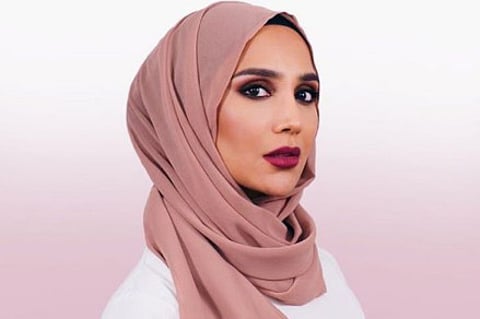Growing weary of the hijab fetish
Amena Khan’s role in a new ad campaign, though short-lived, shows how the industry struggles to represent Muslim women

This month Amena Khan became the first hijabi model to star in a global mainstream hair campaign. L’Oreal, which featured her in its advert, apparently wanted to promote an important message: hair care is for everyone, whether or not they choose to show their hair in public.
I’m not sure who exactly thinks that women in hijab don’t care about their hair because they wear a headscarf in public. Maybe they let their hair dry and wither away into a hijab-shaped husk? Maybe in private they take off their hijab, only to reveal another hijab? But many thanks anyway to L’Oreal for wanting to show that some Muslim women have hair and engage in some form of follicle husbandry.
It wouldn’t be the first time that women were told something obvious in order to sell beauty products via nauseating copy and a model whose looks are a genetic gift rather than a perfect blend of beauty-product success. And it wouldn’t be the first time a company co-opted a symbol of authenticity to sell. Last year, Pepsi was accused of trivialising the Black Lives Matter movement , because of its ad campaign featuring a generic street protest. Sooner or later we’ll be sold sanitary products by a telegenic refugee against the backdrop of a displaced persons’ camp. In fact, I had to Google that to make sure it hadn’t already happened.
Khan’s tenure as Muslim-in-residence was, alas, short-lived. The inevitable historic tweets surfaced: in 2014, she made some comments on Twitter about Israel and, following their discovery, L’Oreal and Khan parted ways . She stepped down from the campaign, saying in a statement : “Championing diversity is one of my passions, I don’t discriminate against anyone. I have chosen to delete [the tweets] as they do not represent the message of harmony that I stand for.” Live by diversity, die by diversity. And now we might never know what further secrets about hijabi women’s hair we might have learned via this groundbreaking campaign.
Of course, this really isn’t about “empowerment”. I am yet to see a context in which that word is deployed where women aren’t being sold to. It’s about money.
This isn’t news. No one is looking to L’Oreal for some deep intersectional thinking here. Wokeness sells, and there is a large Muslim market that advertisers are trying to tap into. But I am growing weary of the hijab fetish that is beginning to dominate popular marketing as a kind of default Muslim emoji.
The one thing possibly more harmful than invisibility is simplistic or tokenistic representation. I am torn between acknowledging that in L’Oreal’s campaign there is a value for people who don’t see themselves represented in the mainstream media, and worrying that we have come to a point where edginess becomes the whole point — where Muslimness becomes collapsed into an image of an over-filtered, hot, bourgeois, fair-skinned hijabi woman, whose highlighter is “on fleek” .
But I know griping about hijiabi models in advertising campaigns at a time when hijabs are being snatched off Muslim women’s heads in hate-crime incidents is not the hill anyone wants to die on. And the fact it annoys people such as Mail on Sunday columnist Peter Hitchens , who had an amusing conniption when H&M used a hijabi model in 2015, suggests that there is a lack of visibility for hijab-wearing women, and that some people would like it to stay that way.
But things are changing, and perhaps overcorrecting. Of the Muslim Girl website’s “ 18 Muslim women to watch in 2018 “, the majority are in hijab. So are many of the women that the media chooses to elevate to political totem status — such as Munira Ahmad , who, wrapped in a stars-and-stripes hijab, became the face of the Trump resistance early last year.
Perhaps that’s because it’s what the well-meaning liberal market wants. How are you to know that a woman is Muslim if she is not in a hijab? How are you to package her? It’s just capitalism going through its motions. Muslims wearing hijabs aren’t the bearers of some innate authenticity. And while there are positive aspects to the way they are being increasingly featured in the media, it can still be pointed out that this kind of exposure can promote stereotypes, rather than eradicate them.
Professor Ted Cantle, who wrote a report on the race riots in northern England in 2001, revisited Blackburn in a report for Panorama this week to find it more divided and segregated than it had ever been. He is damning about official efforts to promote integration but says: “Nadiya Hussain in the Bake Off competition has probably done more for British Muslim relations than 10 years of government policy.” That is both a depressing and a rather encouraging observation. Hussain wasn’t shoehorned into public life. She didn’t win, or go on (despite the abuse she receives) to be a popular, well-loved public figure because she wore the hijab; it was incidental to her success.
I appreciate that sometimes things don’t happen organically, and normalisation needs a helping hand. But the route there isn’t via an ever-more-exclusive obsession with images of people wearing hijabs, in order to reassure people that Muslims too can be attractive and have bodily functions.
“Whether or not your hair is on display,” Amena Khan says in the ad , “doesn’t affect how much you care about it.’’ The irony is that if her hair had indeed been on display in the ad, no one, including L’Oreal, would have cared about it. In a trend that is the absolute opposite of “groundbreaking”, even modesty is being objectified.
— Guardian News & Media Ltd
Nesrine Malik writes a fortnightly column for the Guardian
Sign up for the Daily Briefing
Get the latest news and updates straight to your inbox


